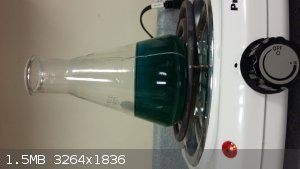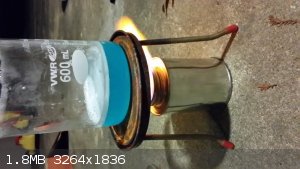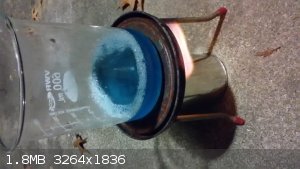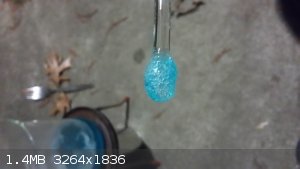Mothman
Harmless

Posts: 42
Registered: 26-9-2017
Member Is Offline
Mood: Aminated
|
|
Chemistry of Sodium Dodecyl Sulfate
I have close to five pounds of this stuff sitting in my basement, but I have no idea what to use it for. I was intending to decellularize some tissue
samples with it but I have way more than what I need for that project so if anyone has any ideas as to what I can do with it, or any knowledge on the
chemistry of it, I would love to hear them. I suspect I could use it as an alkylating agent due to its similarity to sodium ethyl sulfate (+10 carbons
of course), and I might try substituting it for sodium ethyl sulfate in a few things (I might try making nitrododecane, I saw a way to use sodium
ethyl sulfate for that, I wonder if it would work with this stuff) but I do not know what else I could do with this compound, and there seems to be
very little on the chemistry of it. I noticed an interesting reaction with aqueous copper sulfate in boiling water, it produced brown chunks which I
suspect are copper oxide as they reacted with HCl to form a green solution. I suspect what occurred was a reaction similar to that of benedict's
solution and glucose, but I do not know for sure, and I do not know what other products might be formed in such a reaction. If anyone has any ideas
they would be much appreciated! Thank you!
This is a picture of the SDS and copper sulfate solution, I apologize for the poor quality/visibility, by this point the reaction mixture had become
quite dark.
EDIT: Spelling errors and finally figuring out what I really wanted to ask because I'm terrible at communicating.

[Edited on 17-11-2017 by Mothman]
|
|
|
LearnedAmateur
National Hazard
   
Posts: 513
Registered: 30-3-2017
Location: Somewhere in the UK
Member Is Offline
Mood: Free Radical
|
|
Isn't it typically used as an additive in products like shampoos and other liquid/gel hygiene products, under the term 'sodium lauryl sulphate' (could
be wrong on the number of carbons)? If so then I wouldn't think it would be overly reactive, it could be used to alkylate under very forcing
conditions but there is a lot of steric hinderance on a chain that long, especially compared to the ethyl ester which is just a bit smaller than the
HSO4 part of the molecule.
Oh, and there might've been an ion exchange between the SDS and CuSO4 - since sodium salts replace transition metal sulphates, I can imagine a
reaction like this: 2 Na(DS) + CuSO4 -> Na2SO4 + Cu(DS)2. Cu (II) oxide is jet black whereas Cu2O is red, and HCl will displace the dodecyl
sulphate groups to form copper chloride and two lots of dodecyl hydrogensulphate. See if you can crystallise the latter at reduced temperatures or
otherwise extract it, it should melt at 25-27C.
[Edited on 17-11-2017 by LearnedAmateur]
In chemistry, sometimes the solution is the problem.
It’s been a while, but I’m not dead! Updated 7/1/2020. Shout out to Aga, we got along well.
|
|
|
Mothman
Harmless

Posts: 42
Registered: 26-9-2017
Member Is Offline
Mood: Aminated
|
|
I believe you are right about sodium lauryl sulfate being an alternative name for this compound, though a cursory search to determine this did confuse
me as I kept getting results for sodium laurETH sulfate instead of sodium lauryl sulfate, and SLES is not the same compound.
Barring alkylation, for which I doubt I have the reagents necessary for such forcing conditions, what else could be done with this chemical? Would it
be possible to make nitrododecane from this compound using a similar method to making nitroethane from sodium ethyl sulfate? If I were to crack this
using destructive distillation, how much would I need to worry about more dangerous alkylating agents forming such as methyl/ethyl sulfates?
EDIT: Regarding the copper sulfate reaction, I will attempt this reaction again. Though the amounts were arbitrary the first time around, I will go
according to the stoicheometry that you have provided @LearnedAmateur and I will report back as soon as I begin the reaction! Thank you!
[Edited on 17-11-2017 by Mothman]
[Edited on 17-11-2017 by Mothman]
[Edited on 17-11-2017 by Mothman]
|
|
|
LearnedAmateur
National Hazard
   
Posts: 513
Registered: 30-3-2017
Location: Somewhere in the UK
Member Is Offline
Mood: Free Radical
|
|
I've been confused by that in the past, looking through ingredients on bottles and that. Quite different molecules, laureth is somewhat undefined
having multiple ethoxy groups within but they perform pretty much the same function, as ionic surfactants.
I really don't know for SDS in particular, it might be worth your while to just hydrolyse it to dodecanol and work from there. If you have
sodium/potassium nitrite and a mineral acid, you can convert it to the alkyl nitrite. From here, you can convert it to nitrododecane with this general
procedure. I won't link the website because it is well known for detailed clandestine syntheses and I don't feel like it is suitable to mention it.
Since dodecyl nitrite will be a liquid at room temperature, making it into a solution won't be necessary so the important bit is to carry it through a
heated asbestos catalyst.
"The apparatus employed in the case of methyl and ethyl nitrites was the same. The solution of the nitrite in paraffin oil was placed in a flask
provided with an upright spiral condenser, which in turn was connected with a combustion tube about 90 cm. long, filled with asbestos-wool (in order
to expose a large surface to the gaseous nitrites), and heated in an asbestos box provided with a thermometer. The gaseous nitrite was carried into
the tube by means of a slow stream of dry carbon dioxide. The nitro-compound was collected in a U-tube immersed in cold water, and the escaping
nitrite in absolute alcohol or methyl alcohol cooled in ice-water. Fifteen or 20 c.c. of the nitrite solution were used at a time. A 25 per cent.
solution is convenient, and a 50 per cent. solution loses nitrite very rapidly. As the gaseous nitrite remains only momentarily in contact with the
heated asbestos, the yield of the nitro-compound is small, the greater portion of the nitrite escaping conversion. Within four or five hours the
greater part of the dissolved nitrite passes through the heated tube. The oily nitro-compound was easily recognised by the formation of the sodium
compound on the addition of alcoholic sodium hydroxide solution.[1] The nitro-compound was also reduced to the corresponding amine, which was
converted into the platinichloride.
The conversion commenced at 100°C, and was fairly rapid at 120-130°C, when oily drops began to collect in the empty U-tube. At the end of four to
five hours about 1 c.c. of the liquid collected, which responded very readily to the alcoholic sodium hydroxide test. If the temperature is raised to
about 135-150°C, acetaldehyde and acetic acid are produced along with the nitro-compound. At 150-180°C the acid is the main product of the
decomposition. The formation of the aldehyde and the acid is readily explained by the fact, fact that at a higher temperature the nitrite dissociates
into alcohol and nitrous acid, the latter decomposing into nitric acid, and the higher oxides of nitrogen which oxidise the alcohol to the aldehyde
and the acid. The best yield of the nitro-compound is obtained at 120-130°C."
[Edited on 17-11-2017 by LearnedAmateur]
In chemistry, sometimes the solution is the problem.
It’s been a while, but I’m not dead! Updated 7/1/2020. Shout out to Aga, we got along well.
|
|
|
Mothman
Harmless

Posts: 42
Registered: 26-9-2017
Member Is Offline
Mood: Aminated
|
|
So I tried a run of the SLS and CuSO4 experiment again but a few things were different about it than what I had seen last time. For starters, upon
addition of the CuSO4 to the reaction mixture, there was no color change from the normal blue of copper sulfate. I used excess copper sulfate so I
would've put this down to the CuSO4 just washing out the green color but when I commenced heating the water to boiling no color change appeared. As
the heating continued and the solution began to boil, no brown clumps appeared and these were not evident even after ten minutes of boiling. The
foaming of the SLS died down after heating for a while so boiling was fortunately not so messy. Upon cooling, the mixture became a viscous blue gel
that became syrupy upon heating again. I used the following stoicheometric ratios: 1 mole SLS to 2 moles CuSO4. In my experiment I used 15g SLS and
13g CuSO4, and I was hoping that the excess of copper would not affect the reaction, but even at a 1:1 ratio there was no observed color change upon
addition of the two compounds. When I first did this I used two solutions, but this time I just combined two chemicals into a beaker of water...I may
try the same mixing method but this time Ill use a 2:1 ratio of SLS to CuSO4, instead of the other way around.
  
[Edited on 18-11-2017 by Mothman]
You can be happy
|
|
|
Mothman
Harmless

Posts: 42
Registered: 26-9-2017
Member Is Offline
Mood: Aminated
|
|
Ok, I just tried the 2:1 SLS:CuSO4 reaction, and it seems like something happened but not a lot of something. I got traces of a greenish white powdery
substance forming on the bottom of the beaker after about 40-ish minutes of boiling, but apart from that, and a lighter color to the original
solution, everything displayed the same characteristics through the experiment, those being a period of foaming and then a stage at which no foaming
occurs but a strange film begins to form on the surface, presumably SLS, and finally when it all cools it forms a viscous gel similar in appearance to
dawn-brand dish soap...I am beginning to suspect that the original color change I observed was a complex being formed as compared to a chemical
reaction, and I think this because while I saw a color change, I did not observe a precipitate of copper powder, which would've occurred if any copper
(i) lauryl sulfate had been produced due to disproportionation, but it is entirely possible that I was seeing the copper form copper (ii) lauryl
sulfate instead...I will go attempt this experiment again but this time I will use a 4:1 ratio of SLS to CuSO4 and I will begin by dissolving both
reactants in water in order to better observe any color change in the process.
EDIT: Seeing as this thread is mostly about basic chemistry of ionic compounds I will also get started on making some lauryl alcohol to begin
exploring the properties of it.
[Edited on 18-11-2017 by Mothman]
You can be happy
|
|
|
|